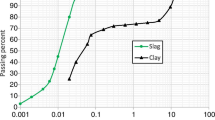Abstract
Clayey soils, especially clayey soils with high or very high liquid limits (> 60%) often present difficulties in construction operations because they usually contain expansive clay minerals. However, the engineering properties of clay soils can be enhanced by the addition of either cement or lime, thereby producing an improved construction material. In this research, slake durability was related to the liquid limit and unconfined compressive strength of clayey admixtures. Three of the most important components in clay soils, namely, kaolinite, montmorillonite and quartz, were combined to make the clayey admixtures. A slaking value of 45% is suggested as identifying satisfactory stabilization. For clayey admixtures with liquid limit between 40% and 60%, this could be achieved with the addition of between 4% and 12% cement. Clayey admixtures with liquid limits over 60% could only achieve this with large uneconomical amounts of cement (> 12%).
Similar content being viewed by others
References
A.S.T.M. D. 558-57. (1976) Moisture-density relations of soil-cement mixtures.
A.S.T.M. D. 559-57. (1976) Standard method for wetting and drying test of compacted soil-cement mixtures.
A.S.T.M. D. 560-57. (1976) Standard method for freezing and thawing test of compacted soil-cement mixtures.
A.S.T.M. D. 1632-63. (1979) Standard method of making and curing soil-cement compression and flexure test specimens in the laboratory.
Bell, F.G. (1976) The influence of the mineral contents of clays on their stabilization by cement. Bulletin of the Association of Engineering Geologists Vol. XIIINo. 4, pp. 267-278.
Bell, F.G. (1978) Foundation Engineering in Difficult Ground. Butterworths, London.
British Standards Institute 1924. (1975) Methods of test for stabilized soils. British Standards Institute, London.
British Standards Institute 1377. (1990) Methods of test for soils for civil engineering purposes. British Standards Institute, London.
Croft, J.B. (1967) The influence of mineralogical composition on cement stabilization. Geotechnique 17, 119-135.
Croft, J.B. (1968) The problem in predicting the suitability of soils for cementitious stabilization. Engineering Geology. Elsevier, Amsterdam, pp. 397-424.
Franklin, J.A. and Chandra, R. (1972) The slake durability test. Int. J. Rock Mech. Min. Sc. Vol. 9, pp.325-341.
Godin, P.M. (1962) Emploi et perspectives de la stabilisation au ciment en technique routiere. Annales de l'institut technique du batiment et des travaux publics. No. 169, pp. 38-64 (in French).
Ingles, D.G. and Metcalf, J.B. (1972) Soil stabilization. Butterworths, Sydney, Australia.
Moh, Z.C. (1965) Reactions of Soil Minerals with Cement and Chemicals. Highway Research Record, No. 86, pp. 39-61.
Portland Cement Association (1959) Soil-cement Laboratory Handbook. Chicago, Illinois, USA.
Raymond, S. (1958) The stabilization of soil with cement. Civil Engineering, pp. 3-7.
Stavridakis, I.E. (1997) A study of slaking related to the unconfined compressive strength of cement stabilized clayey soils. PhD. thesis, Dept. of Civ. Engineering, Aristotelian University of Thessaloniki, Greece (in Greek).
Van Impe, F.W. (1989) Soil improvement techniques and their evolution. AA Bulkema, Rotterdam, Brookfield.
Yoder, E.J. (1967) Principles of Pavement Design. John Wiley and Sons, Inc., U.S.A.
Author information
Authors and Affiliations
Rights and permissions
About this article
Cite this article
Stavridakis, E. Influence of Liquid Limit and Slaking on Cement Stabilized Clayey Admixtures. Geotechnical and Geological Engineering 17, 145–154 (1999). https://doi.org/10.1023/A:1008953005726
Issue Date:
DOI: https://doi.org/10.1023/A:1008953005726




